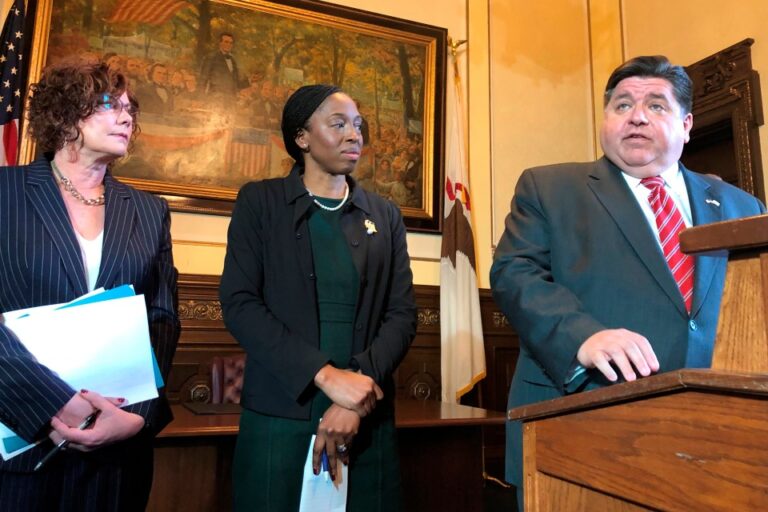CHICAGO – Illinois has received billions in federal relief money during the COVID-19 pandemic. But there will be no new rounds of aid from Washington after federal and state COVID emergency orders expire on May 11.
That means a revenue stream will be drying up for many programs that were launched by state agencies to cope with the far-reaching effects of COVID.
Agencies say they will be able to continue those programs with federal funding until at least 2024, with a requirement that they spend the money by 2026. After that, some programs will wind down because they have served their purpose or they are out of money.
Others will try to keep going with new funding from the state or other sources. That has some lawmakers in Springfield concerned about creating new funding obligations for the state.
Illinois has received $53.8 billion in federal COVID-related aid, according to the Federal Funds Information for States, an agency that tracks funding for state and local governments. That money has gone to the state government, local governments, universities, mass transit agencies and health care providers.
Springfield received $3.5 billion from the Coronavirus Relief Fund to help cover expenses from March 2020 through December 2021. In 2021, the state received another $8.3 billion from the American Rescue Plan. That money was intended to help replace revenues lost by the state during the pandemic lockdown.
The state government has spent more than $8.5 billion of these funds since March 2020, according to the Illinois comptroller’s office. The top spenders the last three years have included the departments of Revenue, Public Health, Healthcare and Family Services, and Commerce and Economic Opportunity.
Carol Knowles from the governor’s Office of Management and Budget said most of the federal aid went toward one-time expenditures, such as paying down debt and adding to the state’s rainy day fund.
“The funding was intended to be used over a period of years,” Knowles said in a written statement. “An example would be federal Elementary and Secondary School Emergency Relief funds that are being disbursed to schools in need that will continue through September 2024.”
That program helped students get access to home internet and other necessary technology for online learning.
The Illinois Department of Public Health has spent just over $1 billion since 2020, according to the comptroller’s office. Dr. Sameer Vohra, director of IDPH, said the federal money allowed the department to fund COVID testing, vaccinations and treatment.
Vohra said his department will “wind down” its spending of the aid after May 11.
“The federal government, through the public health funding, also allowed us to think creatively, to open up grant opportunities to our local health departments to think about innovative ways to address equity challenges around COVID, [and] local health department support,” Vohra said.
He said, going forward, agencies can use lessons learned during the pandemic to determine how they spend future funds. For IDPH, this includes a new information technology system included in Gov. JB Pritzker’s proposed fiscal year 2024 budget that would help IDPH prepare for potential disease outbreaks. Pritzker’s budget also includes $8.5 million to respond to disease outbreaks or other health emergencies.
“Those are really key investments to help us not just with the end of the COVID-19 emergency,” Vohra said, “but really creating the type of preparedness that we need [for] whatever the future public health emergency might look like.”
Some programs started by the state with federal aid during the pandemic could be allowed to continue with funding in the next state budget.
One of them involves grants from the Department of Human Services that were intended to help child-care businesses stay open, especially for parents considered essential workers during the pandemic. The grants also created incentives for child-care workers to stay in the industry.
“We’ve got folks leaving for higher-paying jobs which have less education requirements, and honestly, less hours,” said Shauna Ejeh, senior vice president of programs for Illinois Action for Children.
“And so we know that we’ve got to up our wages and benefits … if we want to attract and retain quality childcare workers, teacher’s assistants, classroom staff — everything from cooks to bus drivers.”
Ejeh said the grants have been extended through June, and she hopes they will be replaced by funding in Pritzker’s budget. His spending plan includes $130 million to begin Early Childhood Workforce Compensation Contracts that would help grow the child-care workforce.
Ejeh said that funding, if it happens, would be a good start, but more would be needed in the future.
That kind of talk concerns some people in Springfield who say the state has become too dependent on federal pandemic aid, creating new programs that would have to be funded solely by the state in the future.
“Once the federal money is gone, our financial outlook will be much worse than it was pre-pandemic because we will have more programs to fund with fewer dollars to fund them,” State Rep. Brad Halbrook, R-Shelbyville, said in a written statement. “We are creating a financial disaster for the State of Illinois because of the lack of fiscal discipline.”
Halbrook, the Republican leader on the Appropriations General Services Committee, said these looming financial shortfalls need to be addressed now, before the state runs out of federal COVID money.
As budget discussions ramp up in the Illinois General Assembly before the scheduled May 19 adjournment, these competing concerns will be in the forefront as legislators debate state spending in the next fiscal year.

